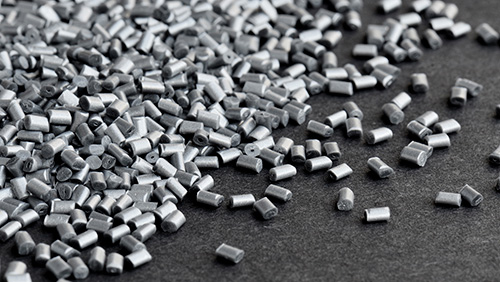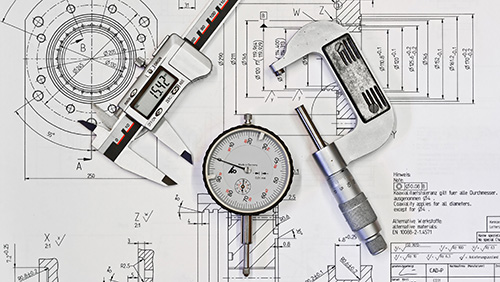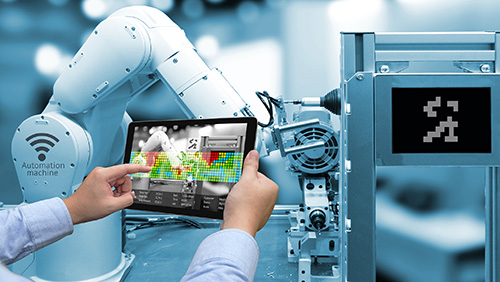Find projects
Find projects
Surface technology
Often, product quality depends on one decisive variable - the quality of the surface. Achieving this through the right settings in the processing procedure is often a challenge. However, speckling, streaks, scratches or even an incorrect design of the surface can already be avoided in the development phase.
In plastics processing, there are also numerous other examples of interface phenomena. These include surface treatments to increase wetting of paints, coatings and adhesives, adhesion forces during bonding and painting, demolding behavior during injection molding, melt residues during hot plate welding, and friction and wear properties of plastics. All these phenomena can be described by characterizing the mechanical surface structure, the chemical-physical surface properties, material composition and adhesion forces, and can thus also be specifically influenced by changing these parameters. In addition to the research and service activities in the described focal areas, the transfer of results is rounded off by specialist conferences, courses and training courses.
Due to our extensive equipment as well as our broad know-how we are glad to help you. Find out more about our activities in this area here.
Services
For varnishes, paints, coatings or adhesives, wetting and adhesion to substrates are decisive quality criteria. On behalf of our customers, we test the bond strengths of coating and adhesive systems to determine suitable application-specific material combinations.
Surface coatings are mainly used for protection, decorative or functional purposes. In most cases, however, it is a combination of these. The term "functional coatings" describes a system that has other functional properties in addition to the classical ones (protection, decoration). At EZD, both the know-how and the equipment are available to modify the coating formulations, apply the new coatings and analyze the finished coatings. Thus, the complete process chain of the coating process can be covered. This applies to both wet paint and powder coatings.
Contact:
Andreas Schneider (EZD) | +49 9287 99880-16 | a.schneider@skz.de
In addition to painting, coating and bonding, there are numerous other examples of interfacial phenomena in plastics processing. The demolding behavior during injection molding, melt residues on the heating element during plastic welding or wall sliding during plastic extrusion are only a few examples. We offer you corresponding support for questions regarding interfacial phenomena.
Knowledge of the condition of a plastic surface is essential for functionalizing surfaces or detecting possible surface defects. At SKZ, a variety of measurement and testing methods are available to characterize the surface structure and topography, the chemistry of the surface with functional groups, and many other mechanical and physical surface properties.
The wetting and adhesion of plastics by paints, varnishes, coatings and adhesives can be increased by various surface treatments. A distinction is made here between mechanical as well as chemical and physical surface treatment methods. At SKZ, various treatment methods are available for preliminary tests.
At SKZ, not only laboratory tests regarding surface analysis are used, but also inline quality assurance methods are constantly developed and validated. We support you in the selection, procurement and development of inline, online or atline measurement methods with regard to color, gloss or surface defects of all kinds.
The tribological properties of plastics are of central importance for many areas of application. Knowledge of friction and wear behavior is essential for mechanically moving systems. Requirements that are often placed on materials in this context are a low coefficient of friction for low energy consumption and good wear resistance to extend maintenance intervals. These parameters can be determined by application-related system tests or standard measurement methods.
As experts in the field of plastics technology, we strive to pass on the knowledge we have acquired over decades to our customers. From material development and manufacturing processes to the application of various testing and measuring methods - in our numerous practice-oriented training courses, you as a participant will acquire the necessary knowledge in dealing with plastics as a material. This begins with the selection of the right materials and compliance with production-oriented design rules, continues with the correct handling of equipment and machines for the production and processing of plastic components and ends with the correct understanding of quality criteria and the associated use of testing and measuring tools.
Bringing together people from different areas of the company and from different sectors to exchange experience and technical know-how is also a top priority for us, in addition to the pure transfer of knowledge. Our numerous specialist events provide the ideal venue for a free exchange of ideas. Renowned speakers from a wide range of industries and excellent technical presentations make the SKZ conference popular meeting places within the plastics industry.
State-of-the-art equipment for best results and products
A look inside our technical center. On more than 1,000 square meters, we offer you service at the highest level. Challenge us. Together we will find a solution for your problem.










Technical equipment
Various characterization methods are available for characterizing the wetting properties of paints, coatings and substrates.
- Drop Shape Analysis System DSA30 for automatic contact angle measurement and measurements of suspended liquid drops (DIN EN ISO 19403, DIN 55660)
- High temperature dosing system for contact angle measurements for the temperature range from 50 °C to 400 °C
- Mobile contact angle measuring system MSA: contact angle measurements with water and diiodomethane
- Tensiometer: Measurement of the interfacial and surface tension of liquids using the plate method
The following coating processes and peripherals are available for surface coating with a focus on powder coating and wet painting. The complete range of substrates (metal, plastic, glass, ceramics, etc.) can be coated.
- Powder coating system: Hand gun with corona charging.
- Squeegee system and spray application for wet paint coating:
- Ultrasonic coating thickness gauge: measuring range 13 - 1,000 μm.
- Scratch resistance, wash and scuff resistance
- Electrical conductivity
- Tensile adhesion testers for automatic peel test to assess adhesion/cohesion of coatings
Contact:
Andreas Schneider (EZD) | +49 9287 99880-16 | a.schneider@skz.de
Various measuring devices are available at SKZ for color measurement on the finished component.
- Laboratory instruments with d/8° spherical geometry (measurements in incident light and transmitted light methods)
- Measuring devices with 45/0° geometry
- Inline colorimeter (45/0°) with integrated temperature sensor
- Inline UV-VIS spectrophotometer
- Glossmeter (20° / 60° / 85°)
Contact:
Dr. Linda Mittelberg | +49 931 4104-458 | l.mittelberg@skz.de
- Reflected and transmitted light microscopes
- X-ray photoelectron spectroscopy (XPS/ESCA)
- Molecular spectroscopy (FT-IR, Raman)
- Electron microscopy (SEM-EDX/ESEM)
The surface topography, roughness and waviness of plastic surfaces are a decisive quality feature for many manufacturing processes or friction processes. For the characterization of surface topography, roughness, waviness or surface structures and shapes, the following testing options are available at SKZ.
- Optical 3D profilometer S neox: operating modes active illuminated focus variation, confocal and (white light) interferometry (DIN EN ISO 25178, DIN EN ISO 21920)
- Confocal laser scanner (SurfScan)
- Tactile roughness tester (profilometer, DIN EN ISO 21920, DIN EN ISO 4287)
- Atomic force microscope (AFM)
- Line scanner
For mechanical, physical and chemical pretreatment of plastic surfaces, an automated pretreatment stand and the following equipment are available for test series.
- Low-pressure plasma (various gases and precursors possible)
- Atmospheric pressure plasma (rotating and static nozzles)
- Corona
- Flame treatment
- VUV emitter
- UV laser
- CO2 laser
- Blasting
- Priming
Often, prior sample preparation is required for the characterization of substrates and test specimens. The following methods can be used here.
- Microtome for sectional preparation
- Grinding and polishing machine
- Resin embedding system
- Sawing
- Water jet cutting
Friction, scratch and abrasion properties, as system properties, are strongly dependent on the test and environmental conditions. For this reason, a wide range of testing options are available at SKZ. Please contact us regarding your specific testing task!
- Tribometer
- Taber Abraser
- UST®-Universal Surface Tester
- Dyna -SPA®
- Abrex®
- Martindale
- Crockmeter
- Automatic washability and abrasion tester (ISO 11988, ASTM D 4213, ASTM D 2486)
- Automatic adhesion tester (DIN EN ISO 16276-1, DIN EN ISO 4624, ASTM D4541)
- Squeegee system including hardness test rod (ISO 1518) and drying time recorder (ISO 9117-4)
3 questions - 3 answers about surface technology
The choice of the right surface pretreatment process cannot be answered in a generalized way. Various factors play a role here, which must be taken into account for the specific component. First of all, the substrate size: Is the component moved under a treatment unit or treated statically? In addition, the material as well as the cleaning condition of the surface are important. Then the geometry and the treatment area must be defined. Complex structures and undercuts have different requirements than planar large surfaces. Are there existing treatment infrastructures, which connections are available, which treatment speeds are to be realized? This and much more has to be taken into account. We are happy to support you independently in the selection and consultation process.
As diverse as the materials, surface pretreatments and process parameters are, so are the possible further processing windows after the activations. In the material, additives, especially processing aids, can migrate to the surface after activation and block generated functionalities. The situation is similar with humidity from the environment, which can condense on the activated surface. The activated surface is not only well wetted by varnish, printing ink or adhesive, but also by water. Added to this are possible dust deposits. Activated surfaces and their functional groups on the surface are also energetically unfavorable, as a result of which these functionalities rotate over time through polymer chain rotations into the bulk material and are thus no longer available for bonding. This effect is material, time and temperature dependent and is also known as the "Hydrophobic Recovery Effect". To get a rough idea, contact angle measurements are often carried out, which characterize the wetting of the surface by the surface free energy with polar and disperse components. Much more precise, but also more cost-intensive, are chemical analyses such as XPS measurements. We therefore recommend checking the processability of the specific component in your own processing operation in order to be able to make reliable statements.
To answer this question, the question of the functionality of the component or the surface must be asked. If the surface serves a decorative purpose, color, gloss and surface topography are relevant, since this is the only way to describe the "appearance". Accordingly, flaws and surface defects are also determined, whereby a wide variety of methods are available for surface topography, depending on whether the surface is mirror-smooth or roughened. If, on the other hand, the surface is to be printed, painted or bonded, the first thing of interest is the wetting of the surface, which is regarded as a necessary condition and is checked, for example, by contact angle measurements. Chemical analyses are then much more precise, for example to detect functional groups quantitatively. Analogously, many other functions of the surface can be characterized by surface resistivity, frictional properties or hardness. Please contact us if you have any questions!







